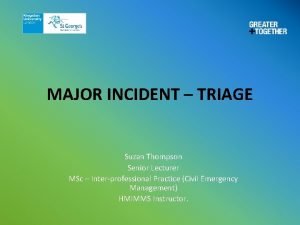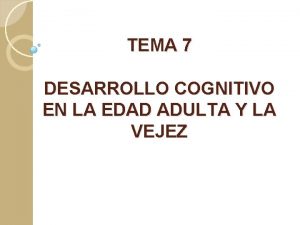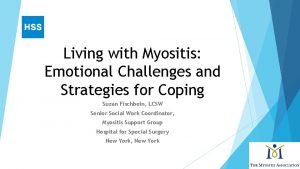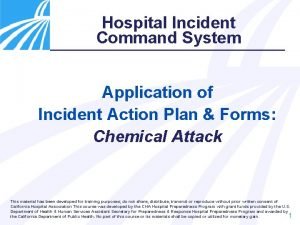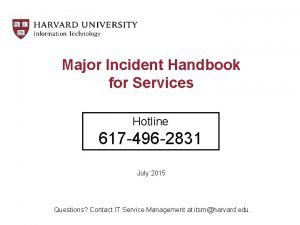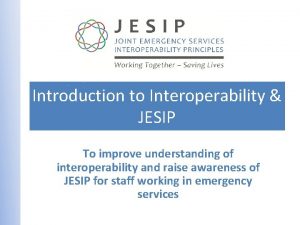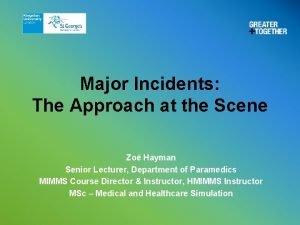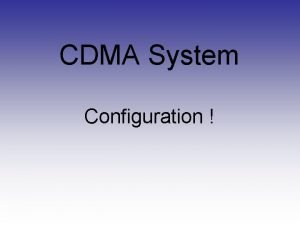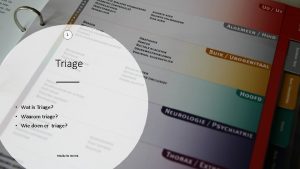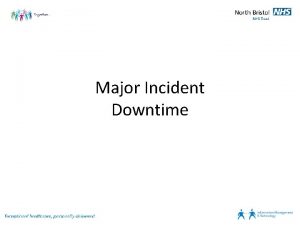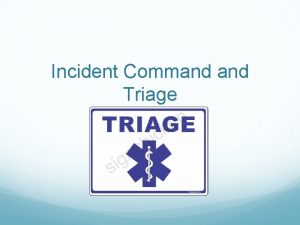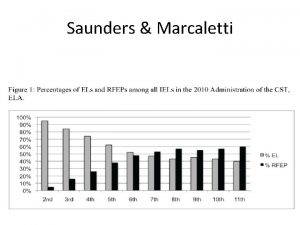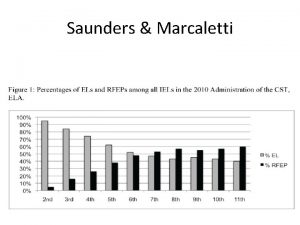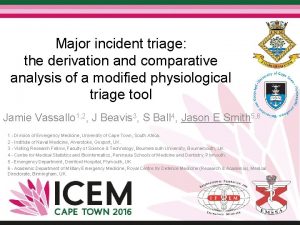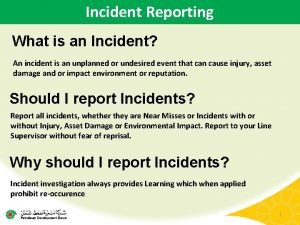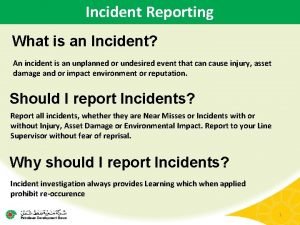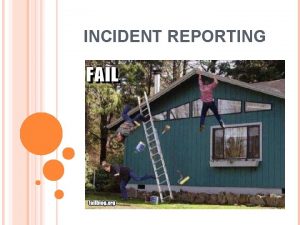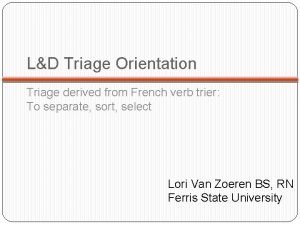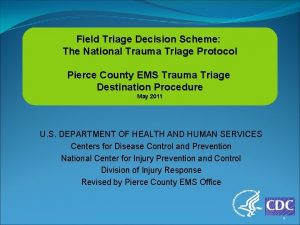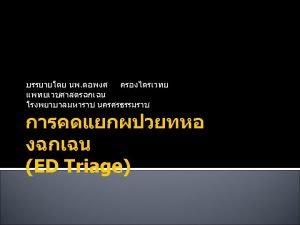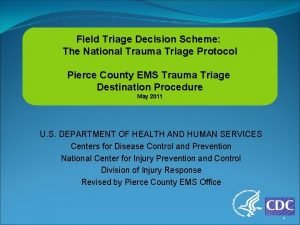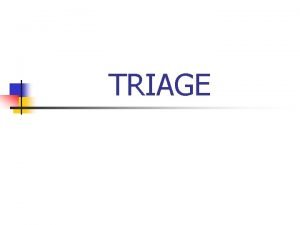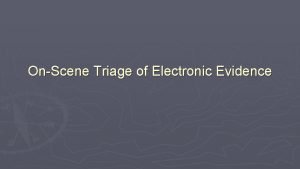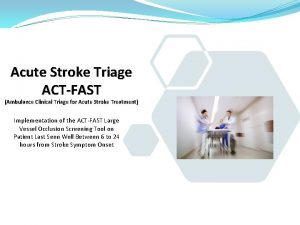MAJOR INCIDENT TRIAGE Suzan Thompson Senior Lecturer MSc
































- Slides: 32

MAJOR INCIDENT – TRIAGE Suzan Thompson Senior Lecturer MSc – Inter-professional Practice (Civil Emergency Management) HMIMMS Instructor. 1

Where to Start?

The Structured Response - CSCATTT • • Command control Safety Communication Assessment Triage Treatment Transport 3

‘Triage is the Keystone of Good Disaster Medical Management’ (Hogan and Burnstein 2002. Pg 10)

Triage • The assignment of degrees of urgency to wounds or illnesses to decide the order of treatment of a large number of patients or casualties • To Sieve or to Sort

Aims of Triage 6

Timing • Dynamic Process (continuous) – At Scene – At CCS – Prior to evacuation – Hospital reception – During resuscitation – Prior to surgery – Prior to admission to ICU / Critical Care Area.

Trimodal Distribution of Death.

Triage Priorities Priority 1. Immediate Category Priority 2. Urgent Category Casualties require immediate life-saving treatment. Casualties require significant intervention as soon as it can be given

Priority 1 (Immediate)

Priority 2 (Urgent)

Triage Priorities Priority 3. Delayed Category These patients will require medical interventions but not urgently.

Priority 3 (Delayed) 13

Triage Priorities Priority 4 Expectant Category. Patients who are so severely injured that any attempts to treat them would have very little chance of a successful outcome. Has never been used invoked in a UK Major Incident.

Priority 4 (Expectant) 15

Triage - Methods • Reliability • Validity – Over-Triage – Under-Triage – Physiological v Anatomical • Triage Sieve (primary) • Triage Sort (secondary)

Triage Sieve ©ALSG, 2012

NARU – Triage Sieve 18

MPTT - 24

Triage Sieve ©ALSG, 2012

NARU – Triage Sieve 21

Triage Sort • Triage Revised Trauma Score • Three Parameters: – Respiratory Rate – Systolic Blood Pressure – GCS • Triage Priority assigned based on score

Respiratory Rate Respiratory rate 0 -4 Value Score 10 -29 4 >29 3 6 -9 2 1 -5 1 0 0

Systolic BP Value Score >90 4 76 -89 3 50 -75 2 1 -49 1 0 0 Systolic BP 0 -4

GCS Value Score 13 -15 4 9 -12 3 6 -8 2 4 -5 1 3 0 GCS 0 -4

TRTS Triage priority + + = Triage sort refines the triage priority with a relevant anatomical description

Triage Labelling • Highly visible. • Dynamic • Easily secured. 27

Triage Labelling

Triage and Evacuation CCS © ALSG, 2012

Triage – Implications for ICU Evaluation of Severity of Injuries. Liaison with Hospital Control Centre Develop Plan. Potential Critical Care admissions need to be evaluated in context of those patients already in the unit • Re-evaluate patients on admission. • •

Any Questions? 31

Summary - Triage • Triage Sieve (quickly assigns priorities) • • • At the scene Dynamic Triage Sort (refines the priorities) • • • More detailed At the Casualty Clearing Station Dynamic – patient’s status may change 32
 Lecturer's name or lecturer name
Lecturer's name or lecturer name Major & suzan
Major & suzan Thompson y thompson
Thompson y thompson Suzan alteri
Suzan alteri Suzan fischbein
Suzan fischbein Suzan van der lee
Suzan van der lee Incident objectives that drive incident operations
Incident objectives that drive incident operations Lecturer in charge
Lecturer in charge Lecturer in charge
Lecturer in charge Pearson lecturer resources
Pearson lecturer resources Spe distinguished lecturer
Spe distinguished lecturer Cfa lecturer handbook
Cfa lecturer handbook Designation lecturer
Designation lecturer 140000/120
140000/120 Teacher good afternoon
Teacher good afternoon Lecturer asad ali
Lecturer asad ali Designation of lecturer
Designation of lecturer Lector vs lecturer
Lector vs lecturer Photography lecturer
Photography lecturer Lecturer name
Lecturer name Why himalayan rivers are pernnial in nature
Why himalayan rivers are pernnial in nature Jeannie watkins
Jeannie watkins Incident hotline
Incident hotline 4 main stages of a major incident jesip
4 main stages of a major incident jesip Four stages of a major incident
Four stages of a major incident Msc marine biogeochemistry
Msc marine biogeochemistry Msc ida ii
Msc ida ii Msc dic
Msc dic Msc agriculture
Msc agriculture Msc finance and banking tor vergata
Msc finance and banking tor vergata Msc eir
Msc eir Jma msc
Jma msc Scan barcode msc
Scan barcode msc

